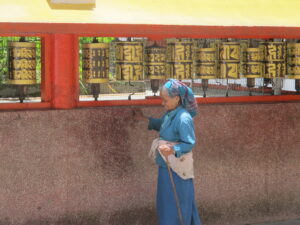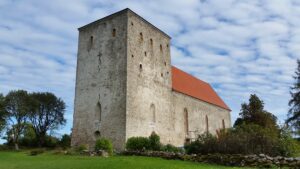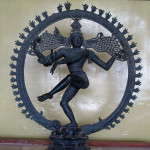
You’ve likely seen the sacred image in bronze many times.
He dances, ringed by tongues of fire, the universe held in balance. The lithe, somewhat androgynous figure stands on his slightly bent right leg, his torso twisted subtly to his right. Beneath this foot is a demon, the evil or ignorance of the material world kept in check.
His fully bent left leg is hoisted high and extended to the right. Two of his four arms gracefully complete the dance, the left reaching across his body, somewhat mirroring his left leg; his right angled toward us with hand upraised in a kind of blessing. His other two arms, elbows bent, aim upwards, balancing each other. In that left hand, he holds a flame, the destructive force; in his right, an hourglass-shaped drum, for the creative force of music and time.
His head faces forward and seems still, a heavenly smile on his face, but from his crowned head stream strands of hair, wind-blown or spun out in the energy of the dance. He is the Nataraja, literally the Lord of the Dance.
Why the dance?
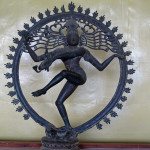
Shiva, the destroyer but also a creator, was the central deity in the Hindu pantheon for the leaders of the kingdoms of southern India, including the Pallavas, Chalukyas and Cholas who wrangled for control over the region from 300AD to 1200AD. Diplomatically, the Southern rulers kept the two other main gods in mind – Brahma, also considered a creator, and Vishnu, the preserver. A significant shrine to Vishnu often found a place in a temple devoted to Shiva.
But Shiva’s dual nature and symbolic power appealed to the southern leaders, as they were quite good themselves at destroying and creating. The dancing god keeps the world in balance, joining the earthly to the divine, linking time and eternity, body and spirit, the worldly and the spiritual, material and immaterial.
The Temple of the Nataraja
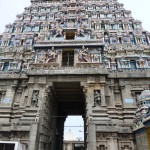
The extraordinary temples built by the dynastic rulers of the south honor this god through beautiful, intricately decorated and harmoniously designed architecture. Many of these complexes devoted to Shiva still stand, often expanded and enhanced by subsequent rulers. Most are active: in them, the god still dwells, attracting the devout to pray in the shrines or do pujas, ceremonial acts such as laying wreaths, lighting candles, etc. Yet they are quite accessible to touring non-believers as well.
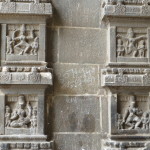
Some remain especially important. Nataraja’s right foot pivots, according to legend and faith, at the Sabhanayaka Nataraja Temple in Chidabaram, Tamil Nadu, a place at the heart of the Chola empire. In style, it’s similar to many ancient, but still active, temples throughout the south. Huge tiered pyramidal towers, or gopuras, top four gateways into the temple complex, each of which is adorned with innumerable divine and mythic figures. The oldest towers at the inner layers are carved from sandstone while the newer ones bloom in color and intensity with stucco. Dance is celebrated throughout the Chidambaram temple complex, particularly on the gopuras, where guardian figures dance their attendance along the tiers. Below them, adorning the arched entryways, stone bas-reliefs of dancers demonstrate all the postures of classical dance.
Finding your way within is like entering a maze, for nesting inside are other walled enclosures and huge gathering halls, or mandapas. You know something very powerful is happening inside. A gleaming dark pervades everything, with wisps of light peeking through the minuscule holes and few windows onto the granite and basalt used for the structures, blackened by hundreds of years of candle, oil and incense smoke. Artisans also sculpted hundreds of ornate columns and large ornamental figures out of the long-lasting stone. Shrines proliferate in available nooks and side passages.
It’s at the innermost layer, where non-Hindus may not go, that the living Shiva still dances and a crystal Shivalingam glows, a phallic column representing the potency of the god. Just outside it, a granite enclosure with massive bronze doors is opened to view at set times throughout the day. Bells ring out 12 times. Then Shiva’s priests light dedicatory fires as the faithful gather at the doors to murmur prayers and marvel, craning for a vision of the god within.
Other Temples Honoring Shiva
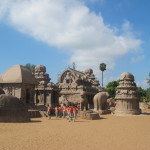
Traveling through Tamil Nadu and Karnataka in particular brings a visitor through about 1500 years of Shiva worship in elaborate temples like these. In the 6th and 7th century, when temples were first gouged out of sandstone caves, Shiva might dance in less graceful fashion and with a lot more arms.
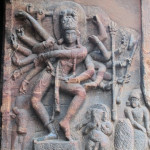
The origins of southern India’s tiered towers and imagery can be seen partly in the “subtractive” approach used for caves, like the archetypal model at the pyramidal ratha of the 7th century in Mahaballipuram. And even more so in the “additive” methods – stone blocks upon blocks – still viewable at the twin towers of the 8th century Shore Temple there. Beautifully sited on the beach, that Pallavan temple is one of the oldest surviving free-standing ones.
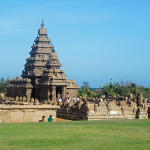
These models set the style for subsequent southern Indian temples, and made the local stone-carving artisans treasured workers. By building mini-temples and carving out natural sandstone rock faces all around Mahaballipuram, the artisans created a showroom of their craft and optional temple extras – a display area hectares in size. Today even their descendants work brilliantly in stone and its successor material stucco, as they are pleased to demonstrate at their shops in town.
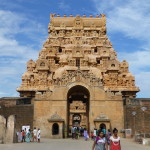
By the Chola period of the 10th thru 12th century, the creation of elaborate structures in sandstone and granite had hit its stride. The much admired Brihadishvara Temple at Thanjavur(10th to 11th century) is a relatively simple two-layered complex with a spacious courtyard between the layers.
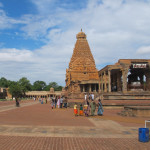
However, Thanjavur’s sandstone gopuras climb half a dozen levels high. Along with the main shrine’s tower, they are rich in myriad carvings, among them the familiar pose of Shiva.
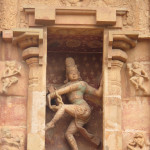
Similarly, the elegant temples of Gangaikondacholapuram (11th c.) and Darasuram (12th c.), though without showy gateways, demonstrate the level of artistry achieved as the Cholas consolidated their power and wealth.
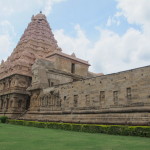
While Shiva had long been dancing in stone at temples like these, the Cholan mastery of bronze work added a new level of subtlety, intricacy and impact to his representation, as well as to the depiction of the myriad other gods, attendants and storied characters. Most Chola bronzes, however, are now scattered around the world in major museums. But, at both of these temples, you can see many of the bronze images still in place as intended.
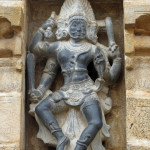
At Thanjavur, moreover, a private collection displayed at a former palace also offers a surprisingly rich assembly of bronzes, including a breath-taking display of whirling natarajas.
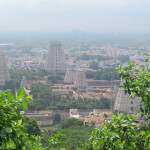
The most important temples dating from the Cholas, like Chidabaram, evolved over time into multi-layered complexes. The inner shrines where Shiva’s lingam of black stone rises, the most sacred parts of temples, saw additions and extensions by later dynasties. The 10 hectare complex of Arunachaleshvara Temple in Thiruvanamalai, for example, has long been important because it is the one to celebrate the red mountain looming above it – a volcanic one, in fact – as a Shiva lingam of fire.
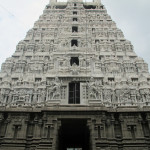
The complex may have only three layers to it, with large elaborate stone gopuras at the outer layer of walls, including the one of the tallest in India at 66 meters, all enhanced over hundreds of years. But the nesting of added temples and shrines over time has made the place dizzyingly complicated too.
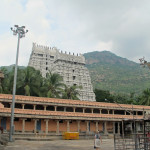
At other revered temples like Chidambaram and the central one at Madurai, subsequent rulers and rajahs also kept adding new layers of rectangular walls around their central shrines and added larger gateway towers. By the 16th century, stonework yielded to brightly painted stucco figures and more tiers of decoration on the towers, as a way of besting prior rulers.
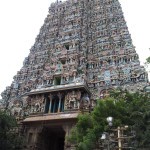
They’re either outrageous or stunning depending on your appetite for excess, as later rulers put their all into the detailing. At least they still provide much repair work for those stone and stucco artisans. The stucco figures adorning gateways and shrines must be repainted and repaired every ten years, a two year task.
Shiva’s Marriage Bed
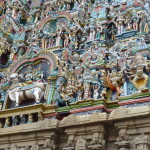
The 7-layer Madurai, with its huge, ornate stuccoed gateways, has long been an essential place for pilgrims and festivals. Appropriately, inside one of its large mandapa halls, there is yet another dazzling collection of the ancient bronze craftsmanship and stone artistry of the south.
Most importantly, however, here the living god Shiva also dwells – though he has more than dancing on his mind. The Madurai temple is nominally dedicated to his wife, Parvathi, in one of her incarnations as Meenakshi, or “the fish-eyed”, yes, a term of beauty. Here every day Parvathi and Shiva, creator as well as destroyer, ensure the fecundity of the world through their sexual union.
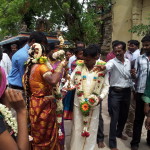
To that end, with a thronged ceremony in the evening, priests move the divine icons from the inner shrines to their “bedchamber.” Not surprisingly, couples flock here to be married and women offer prayers for help becoming pregnant.
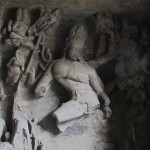
It’s no wonder that Hindus of the past – and present – so fervently honor Shiva, for his essential acts of love and dance – whether by holy ceremonies, or in the ancient temple structures dedicated to the god, or through those exquisite stone carvings and Chola bronzes.
(Also, for more pictures from India, CLICK HERE to view the slideshow at the end of the India itinerary page.)




